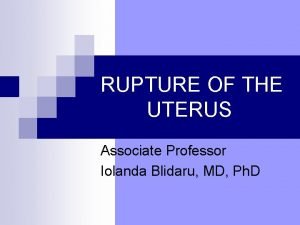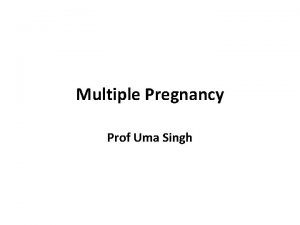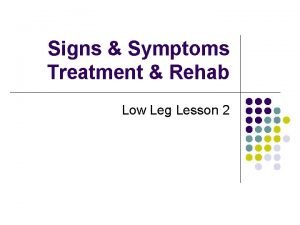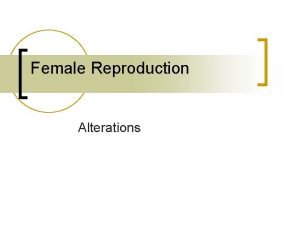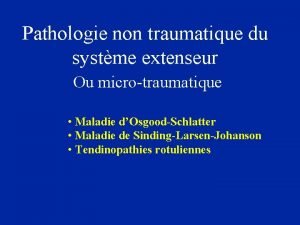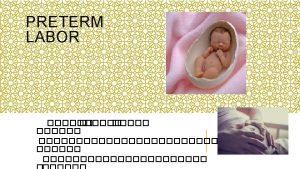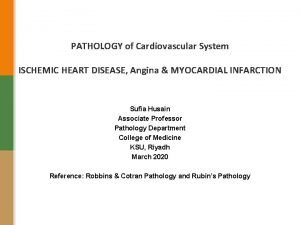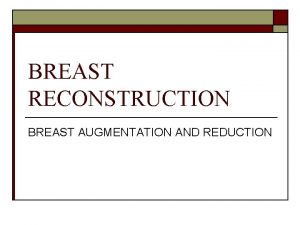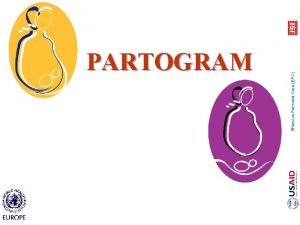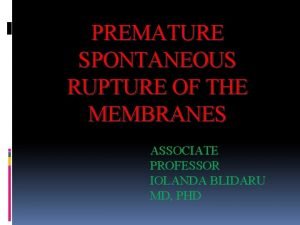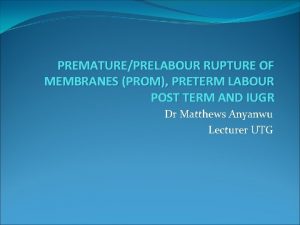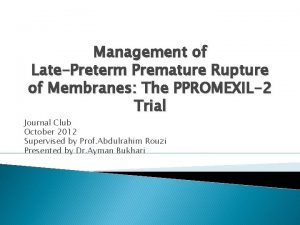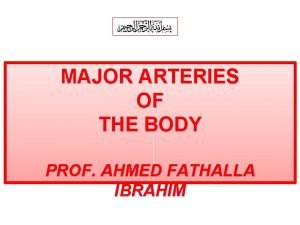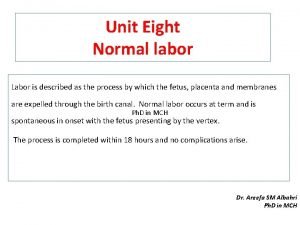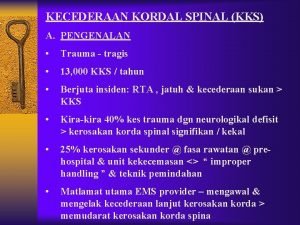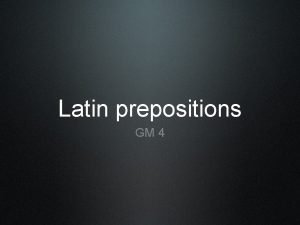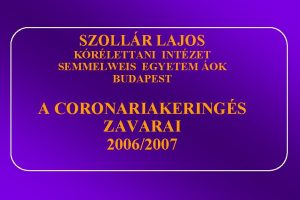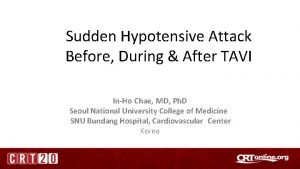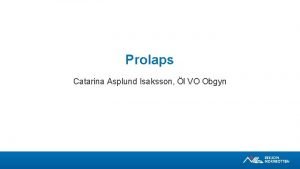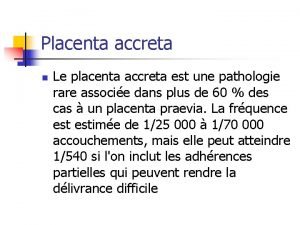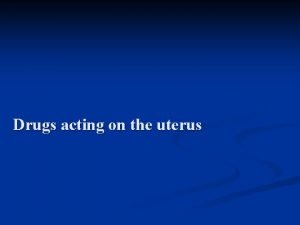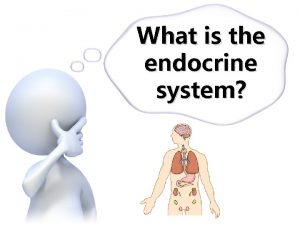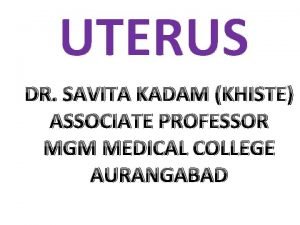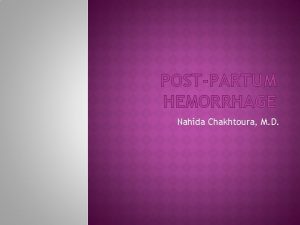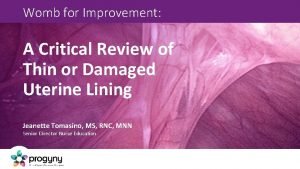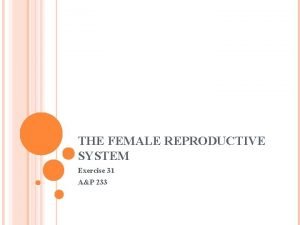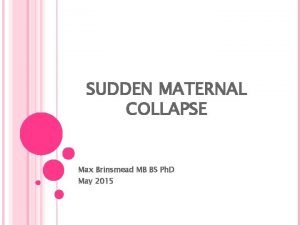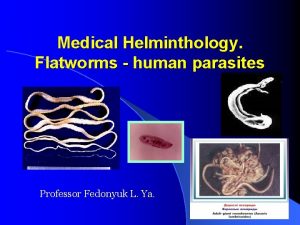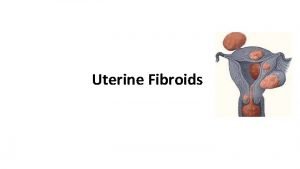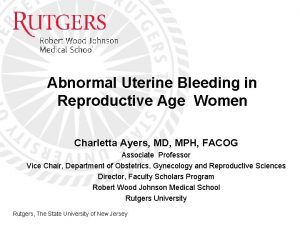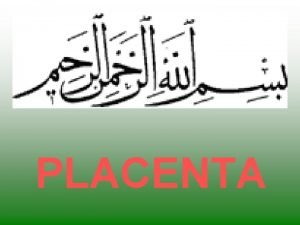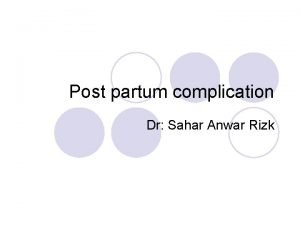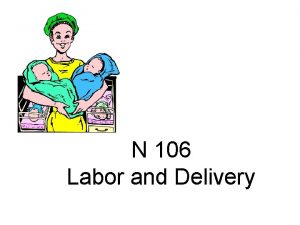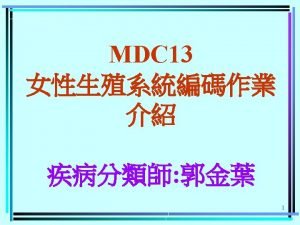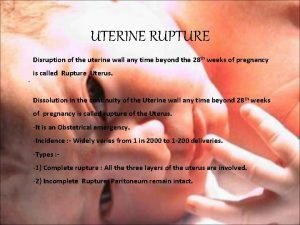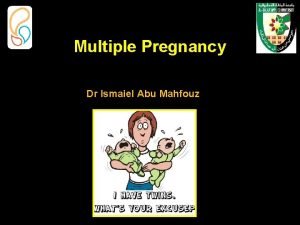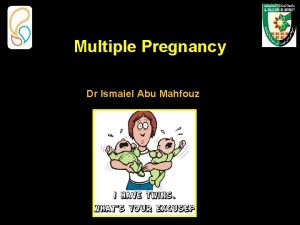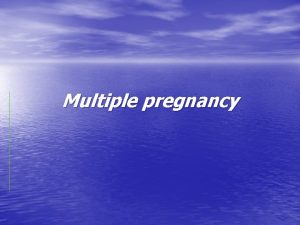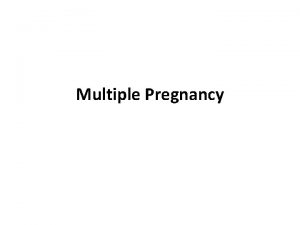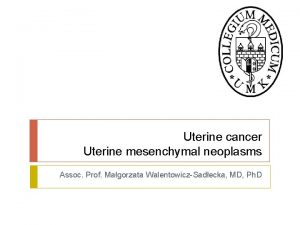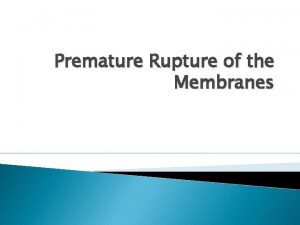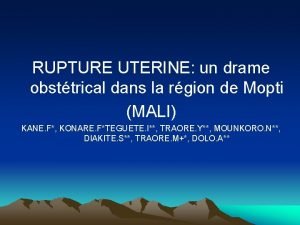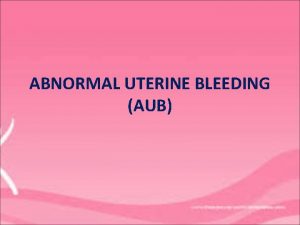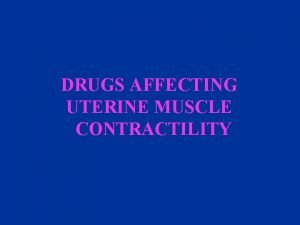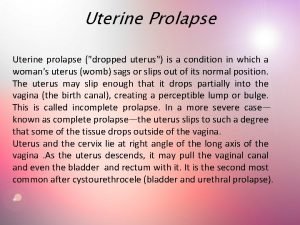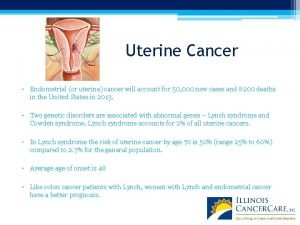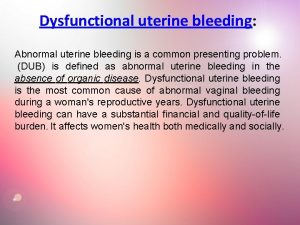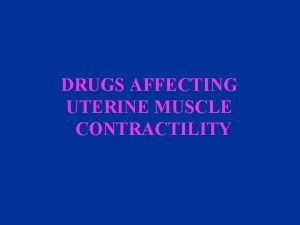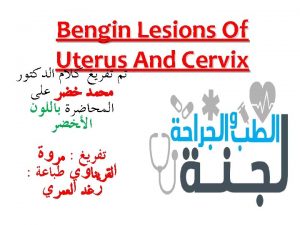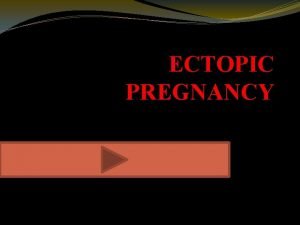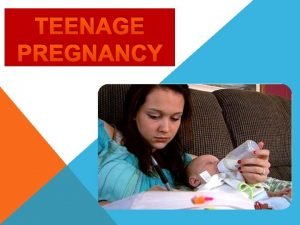Lecture 14 MULTIPLE PREGNANCY THE UTERINE RUPTURE Prof





















































- Slides: 53

Lecture 14 MULTIPLE PREGNANCY. THE UTERINE RUPTURE Prof. Vlad TICA, MD, Ph. D

MULTIPLE PREGNANCY


MULTIPLE PREGNANCY Twin pregnancy represents 2 to 3% of all pregnancies The PNMR is 5 times that of singleton

DIZYGOTIC TWINS Most common represents 2/3 of cases Fertilization of more than one egg by more than one sperm Non identical, may be of different sex Two chorion and two amnion Placenta may be separate or fused

FACTORS AFFECTING IT’S INCIDENCE Induction of ovulation, 10% with clomide and 30% with gonadotrophins Increase maternal age ? Due to increase gonadotrophins production Increases with parity Heredity usually on maternal side Race: Nigeria 1: 22; North America 1: 90

MONOZYGOTIC TWINS Constant incidence of 1: 250 births Not affected by heredity Not related to induction of ovulation Constitutes 1/3 of twins

RESULTS FROM DIVISION OF FERTILIZED EGG 0 -72 hours Diamniotic dichorionic 4 -8 days Diamniotic monochorionic 9 -12 days Monoamnio monochorionic >12 days Conjoined twins

RESULTS FROM DIVISION OF FERTILIZED EGG

MONOZYGOTIC TWINS 70% are diamniotic monochorionic 30% are diamniotic dichorionic

DETERMINATION OF ZYGOSITY Very important as most of the complications occur in monochorionic monozygotic twins

During pregnancy by USS Very accurate in the first trimester, two sacs, presence of thick chorion between amniotic membranes Less accurate in the second trimester the chorion become thin and fuse with the amniotic membranes

Different sex indicates dizygotic twins Separate placentas indicates dizygotic twins

DETERMINATION OF ZYGOZITY AFTER BIRTH By examination of the MEMBRANES, PLACENTA, SEX, BLOOD group Examination of the newborn DNA and HLA may be needed in few cases

COMPLICATIONS OF MULTIPLE GESTATION Maternal Anemia Hydramnios Preeclampsia Preterm labour Postpartum hemorrhage Cesarean delivery Fetal Malpresentation Placenta previa Abruptio placentae Premature rupture of the membranes Prematurity Umbilical cord prolapse Intrauterine growth restriction Congenital anomalies

SPECIFIC COMPLICATIONS IN MONOCHORIONIC TWINS TWIN-TWIN transfusion Results from vascular anastomosis between twins vessels at the placenta Usually arterio (donor) venous (recipient) Occurs in 10% of monochorionic twins

SPECIFIC COMPLICATIONS IN MONOCHORIONIC TWINS TWIN-TWIN transfusion Chronic shunt occurs, the donor bleeds into the recipient so one is pale with oligohydraminos while the other is polycythemic with hydraminos If not treated death occurs in 80 -100% of cases

SPECIFIC COMPLICATIONS IN MONOCHORIONIC TWINS Possible methods of treatment: Repeated amniocentesis from recipient Indomethacin Fetoscopy and laser ablation of communicating vessels

OTHER COMPLICATIONS IN MONOCHORIONIC TWINS Congenital malformation. Twice that of singleton. Umbilical cord anomalies. In 3 – 4 %. Conjoined twins. Rare 1: 70000 deli varies. The majority are thoracopagus PNMR of monochorionic is 5 x that of dichorionic twins (120 vs. 24 / 1000 births)

OTHER COMPLICATIONS IN MONOCHORIONIC TWINS - thoracopagus - pigopagus

OTHER COMPLICATIONS IN MONOCHORIONIC TWINS - craniopagus parasiticus - xyphopagus

MATERNAL PHYSIOLOGICAL ADAPTATION Ø Increase blood volume and cardiac output Ø Increase demand for iron and folic acid Ø Maternal respiratory difficulty Ø Excess fluid retention and edema Ø Increase attacks of supine hypotension

DIAGNOSIS OF MULTIPLE PREGNANCY Ø Positive family history mainly on maternal side Ø Positive history of ovulation induction Ø Exaggerated symptoms of pregnancy Ø Marked edema of lower limb Ø Discrepancy between date and uterine size Ø Palpation of many fetal parts

DIAGNOSIS OF MULTIPLE PREGNANCY Ø Auscultation of two fetal heart beats at two different sites with a difference of 10 beats Ø USS Ø Two sacs by 5 weeks by TV USS Ø Two embryos by 7 weeks by TV USS

ANTENATAL CARE AIM Prolongation of gestation age, increase fetal weight Improve PNM and morbidity Decrease incidence of maternal complications

ANTENATAL CARE Follow Up Every 2 weeks Iron and folic acid to avoid anemia Assess cervical length and competency

ANTENATAL CARE Fetal Surveillance Monthly USS from 24 weeks to assess fetal growth and weight A discordinate weight difference of >25% is abnormal (IUGR) Weekly CTG from 36 weeks

3 D USS – TWIN PREGNANCIES

METHOD OF DELIVERY Vertex-Vertex (50%) Vaginal delivery, interval between twins not to exceed 20 minutes Vertex-Breech (20%) Vaginal delivery by senior obstetrician

METHOD OF DELIVERY Breech-Vertex (20%) Safer to deliver by CS to avoid the rare interlocking twins (1: 1000 twins) Breech-Breech (10%) Usually by CS

PERINATAL OUTCOME PNMR is 5 times that of singleton (30 -50/1000 births) RDS accounts for 50% 0 f PNMR. 2 nd twin is more affected Birth trauma – 2 nd twin is 4 times affected than 1 st Incidence of SB is twice that of singleton

PERINATAL OUTCOME Congenital anomalies is responsible for 15% of PNMR Cerebral hemorrage and birth asphyxia are responsible for 10% of PNMR Cerebral palsy is 4 times that of singleton 50% of twins babies are born with low birth (<2500 gms) from prematurity & IUGR

INTRAUTERINE DEATH OF ONE TWIN Ø Early in pregnancy usually no risk Ø In 2 nd or 3 rd trimester: Ø Increase risk of DIC Ø Increase risk of thrombosis in the a live one Ø The risk is much higher in monochorionic than in dichorionic twins

The a life baby should be delivered by 32 -34 weeks in monochorionic twins

HIGH RANK MULTIPLE GESTATION Spontaneous triplets 1: 8. 000 births Spontaneous quadruplets 1: 700. 000 births The main risk is sever prematurity CS is the usual and safe mode of delivery High PNMR of 50 -100 / 1000 births

COMPLICATIONS OF MULTIPLE PREGNANCY A. MATERNAL: 1. Anemia due to increase demand 2. Increase incidence of PET(5 times) 3. Polyhydramnios in monochorionic monozygotic twins 4. Increase incidence of premature labor

COMPLICATIONS OF MULTIPLE PREGNANCY A. MATERNAL: 5. Increase incidence of CS. And operative delivery 6. Increase incidence of placenta praevia and abruptio placentae 7. Increase incidence of hypotonic postpartum hemorrhage

COMPLICATIONS OF MULTIPLE PREGNANCY B. FETAL: 1. Increase perinatal morbidity and mortality 2. Prematurity with / without rupture of membrane 3. Increase incidence of malpresentation

COMPLICATIONS OF MULTIPLE PREGNANCY B. FETAL: 4. Increase incidence of cord prolapse 5. Higher incidence of IUGR 6. Increase incidence of congenital anomalies

THE UTERINE RUPTURE

DEFINITION Separation of the muscular wall of the uterus Usually occurs during labor Occasionally happen during the later weeks of pregnancy

CAUSES During pregnancy Weak scar after previous operations on the uterus History of cesarean section (VBAC - vaginal birth after C-section) Myomectomy Excision of a uterine septum Previous perforation of uterus (D&C, hysteroscopy, forceps delivery

CAUSES During labor: uterine hyper-stimulation (oxytocin with pitocin induction or augmentation of labor) obstructed labor (macrosomia, fetopelvic disproprotion) intrauterine manipulation (internal version, manual removal of an adherent placenta) forcible dilatation (cervical tear) a weak scar (C-section or other

TYPES Incomplete rupture Complete rupture Depending on whether the peritoneal coat is torn through or not



SYMPTOMS AND SIGNS 1. Rupture of scar be gradual that symptom is very slight in incomplete rupture abdominal pain wrongly attributed to the onset of labor severe pain and shock occurs in complete (suddenly pain) fetal distress bleeding in vagina

SYMPTOMS AND SIGNS 2. Spontaneous rupture during obstructed labor prolonged labor violent uterine actions pathologic retraction ring disporpotion, malpresentation(transverse lie) fetal distress a sharp, tearing pain in lower abdomen pulse rapid blood pressure fall fetus may be felt in the abdominal cavity

PATHOLOGIC RETRACTION RING

SYMPTOMS AND SIGNS 3. Rupture by oxytocin drugs: be follow the administration of oxytocin the danger is less if the drug is given as a dilute intravenous drip given in an increasing fashion

PROGNOSIS has a high mortality peri-natal morbidity is high

TREATMENT Women’s general condition must be improved giving morphine, blood transfusion, glucose solution) immediate laparotomy hysterectomy wide-spectrum antibiotics

THANKS FOR YOUR ATTENTION !
 Uterine rupture
Uterine rupture Definition of spotting during pregnancy
Definition of spotting during pregnancy Multiple pregnancy nursing diagnosis
Multiple pregnancy nursing diagnosis 01:640:244 lecture notes - lecture 15: plat, idah, farad
01:640:244 lecture notes - lecture 15: plat, idah, farad Achilles tendon rupture moi
Achilles tendon rupture moi Ovarian cyst bleeding
Ovarian cyst bleeding Cerclage haubanage rotule
Cerclage haubanage rotule Rupture exposure radius
Rupture exposure radius Maladie de sinding larsen
Maladie de sinding larsen Premature rupture of membranes management
Premature rupture of membranes management Rupture
Rupture Intracapsular implant rupture treatment
Intracapsular implant rupture treatment Plot partogram
Plot partogram Achilles tendon rupture moi
Achilles tendon rupture moi Differential diagnosis for premature rupture of membranes
Differential diagnosis for premature rupture of membranes Tocolytic drugs
Tocolytic drugs Premature rupture of membranes management
Premature rupture of membranes management Brachiocephalic trunk
Brachiocephalic trunk Halifax man butane explosion
Halifax man butane explosion Artificial rupture of membranes
Artificial rupture of membranes Volcanic rupture
Volcanic rupture What is true labor
What is true labor Fungsi rupture disc
Fungsi rupture disc What is amniotic fluid embolism
What is amniotic fluid embolism Rupture cda
Rupture cda Cerclage rotule
Cerclage rotule Unscramble rupture
Unscramble rupture Artificial rupture of membranes
Artificial rupture of membranes Plaque rupture
Plaque rupture Annular rupture tavr
Annular rupture tavr Diastasis tibio talien
Diastasis tibio talien Multiple probe vs multiple baseline
Multiple probe vs multiple baseline Shared memory mimd architecture
Shared memory mimd architecture Prolaberat
Prolaberat Uterine atony treatment
Uterine atony treatment Synéchie utérine traitement naturel
Synéchie utérine traitement naturel Uterine stimulants and relaxants
Uterine stimulants and relaxants Thickening of uterine lining
Thickening of uterine lining Lig pubocervicale
Lig pubocervicale Rciu dysharmonieux fémur
Rciu dysharmonieux fémur Female reproductive system pathology
Female reproductive system pathology B lynch suture
B lynch suture Anemia and uterine atony
Anemia and uterine atony Ignant review womb for improvement
Ignant review womb for improvement Uterine tube
Uterine tube Uterine inversion
Uterine inversion Biohelminthes
Biohelminthes Gastric
Gastric Bonney hood operation
Bonney hood operation Vaginal bleeding
Vaginal bleeding Developing fetus
Developing fetus Bimanual compression
Bimanual compression Perineal massage
Perineal massage Cystocele with incomplete uterine prolapse
Cystocele with incomplete uterine prolapse
